+ Open data
Open data
- Basic information
Basic information
| Entry | Database: PDB / ID: 1h9v | ||||||
|---|---|---|---|---|---|---|---|
| Title | Human Fc-gamma-Receptor IIa (FcgRIIa), monoclinic | ||||||
 Components Components | LOW AFFINITY IMMUNOGLOBULIN GAMMA FC RECEPTOR II-A | ||||||
 Keywords Keywords |  IMMUNE SYSTEM / IMMUNE SYSTEM /  MEMBRANE PROTEIN / FCR / FC-RECEPTOR / MEMBRANE PROTEIN / FCR / FC-RECEPTOR /  IMMUNOGLOBULIN / FCGR / FC-GAMMA-R IMMUNOGLOBULIN / FCGR / FC-GAMMA-R | ||||||
| Function / homology |  Function and homology information Function and homology informationIgG binding /  immune system process / FCGR activation / immune system process / FCGR activation /  regulation of immune response / Role of phospholipids in phagocytosis / FCGR3A-mediated IL10 synthesis / secretory granule membrane / Regulation of actin dynamics for phagocytic cup formation / transmembrane signaling receptor activity / cell surface receptor signaling pathway ...IgG binding / regulation of immune response / Role of phospholipids in phagocytosis / FCGR3A-mediated IL10 synthesis / secretory granule membrane / Regulation of actin dynamics for phagocytic cup formation / transmembrane signaling receptor activity / cell surface receptor signaling pathway ...IgG binding /  immune system process / FCGR activation / immune system process / FCGR activation /  regulation of immune response / Role of phospholipids in phagocytosis / FCGR3A-mediated IL10 synthesis / secretory granule membrane / Regulation of actin dynamics for phagocytic cup formation / transmembrane signaling receptor activity / cell surface receptor signaling pathway / Neutrophil degranulation / regulation of immune response / Role of phospholipids in phagocytosis / FCGR3A-mediated IL10 synthesis / secretory granule membrane / Regulation of actin dynamics for phagocytic cup formation / transmembrane signaling receptor activity / cell surface receptor signaling pathway / Neutrophil degranulation /  plasma membrane plasma membraneSimilarity search - Function | ||||||
| Biological species |   HOMO SAPIENS (human) HOMO SAPIENS (human) | ||||||
| Method |  X-RAY DIFFRACTION / X-RAY DIFFRACTION /  MOLECULAR REPLACEMENT / Resolution: 3 Å MOLECULAR REPLACEMENT / Resolution: 3 Å | ||||||
 Authors Authors | Sondermann, P. / Kaiser, J. / Jacob, U. | ||||||
 Citation Citation |  Journal: J.Mol.Biol. / Year: 2001 Journal: J.Mol.Biol. / Year: 2001Title: Molecular Basis for Immune Complex Recognition: A Comparison of Fc-Receptor Structures Authors: Sondermann, P. / Kaiser, J. / Jacob, U. | ||||||
| History |
|
- Structure visualization
Structure visualization
| Structure viewer | Molecule:  Molmil Molmil Jmol/JSmol Jmol/JSmol |
|---|
- Downloads & links
Downloads & links
- Download
Download
| PDBx/mmCIF format |  1h9v.cif.gz 1h9v.cif.gz | 45.6 KB | Display |  PDBx/mmCIF format PDBx/mmCIF format |
|---|---|---|---|---|
| PDB format |  pdb1h9v.ent.gz pdb1h9v.ent.gz | 32 KB | Display |  PDB format PDB format |
| PDBx/mmJSON format |  1h9v.json.gz 1h9v.json.gz | Tree view |  PDBx/mmJSON format PDBx/mmJSON format | |
| Others |  Other downloads Other downloads |
-Validation report
| Arichive directory |  https://data.pdbj.org/pub/pdb/validation_reports/h9/1h9v https://data.pdbj.org/pub/pdb/validation_reports/h9/1h9v ftp://data.pdbj.org/pub/pdb/validation_reports/h9/1h9v ftp://data.pdbj.org/pub/pdb/validation_reports/h9/1h9v | HTTPS FTP |
|---|
-Related structure data
| Related structure data |  2fcbS S: Starting model for refinement |
|---|---|
| Similar structure data |
- Links
Links
- Assembly
Assembly
| Deposited unit | 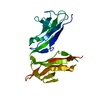
| ||||||||
|---|---|---|---|---|---|---|---|---|---|
| 1 |
| ||||||||
| Unit cell |
|
- Components
Components
| #1: Protein | Mass: 19342.645 Da / Num. of mol.: 1 / Fragment: IMMUNOGLOBULIN G BINDING DOMAIN RESIDUE 5-177 Source method: isolated from a genetically manipulated source Source: (gene. exp.)   HOMO SAPIENS (human) / Description: REFOLDED FROM INCLUSION BODIES / Cellular location: EXTRACELLULAR HOMO SAPIENS (human) / Description: REFOLDED FROM INCLUSION BODIES / Cellular location: EXTRACELLULAR Glossary of biology / Variant: HIGH RESPONDER / Plasmid: PET / Cellular location (production host): INCLUSION BODIES / Production host: Glossary of biology / Variant: HIGH RESPONDER / Plasmid: PET / Cellular location (production host): INCLUSION BODIES / Production host:   ESCHERICHIA COLI (E. coli) / Strain (production host): BL21(DE3) / References: UniProt: P12318 ESCHERICHIA COLI (E. coli) / Strain (production host): BL21(DE3) / References: UniProt: P12318 |
|---|---|
| Compound details | BINDS TO THE FC REGION OF IMMUNOGLOB |
-Experimental details
-Experiment
| Experiment | Method:  X-RAY DIFFRACTION / Number of used crystals: 1 X-RAY DIFFRACTION / Number of used crystals: 1 |
|---|
- Sample preparation
Sample preparation
| Crystal | Density Matthews: 2.29 Å3/Da / Density % sol: 46 % | ||||||||||||||||||||||||||||||||||||
|---|---|---|---|---|---|---|---|---|---|---|---|---|---|---|---|---|---|---|---|---|---|---|---|---|---|---|---|---|---|---|---|---|---|---|---|---|---|
Crystal grow | pH: 5.5 / Details: 0.2M NAOAC PH 4.6, 26% PEG 8000 | ||||||||||||||||||||||||||||||||||||
| Crystal grow | *PLUS Temperature: 20 ℃ / pH: 7.2 / Method: vapor diffusion, sitting drop | ||||||||||||||||||||||||||||||||||||
| Components of the solutions | *PLUS
|
-Data collection
| Diffraction | Mean temperature: 291 K |
|---|---|
| Diffraction source | Source:  ROTATING ANODE / Type: RIGAKU RU200 / Wavelength: 1.5418 ROTATING ANODE / Type: RIGAKU RU200 / Wavelength: 1.5418 |
| Detector | Type: MARRESEARCH / Detector: IMAGE PLATE / Date: Mar 15, 2000 |
| Radiation | Monochromator: NI FILTER / Protocol: SINGLE WAVELENGTH / Monochromatic (M) / Laue (L): M / Scattering type: x-ray |
| Radiation wavelength | Wavelength : 1.5418 Å / Relative weight: 1 : 1.5418 Å / Relative weight: 1 |
| Reflection | Resolution: 3→50 Å / Num. obs: 3417 / % possible obs: 90.5 % / Observed criterion σ(I): 2 / Redundancy: 2.4 % |
| Reflection | *PLUS Rmerge(I) obs: 0.111 |
| Reflection shell | *PLUS % possible obs: 69 % / Rmerge(I) obs: 0.242 |
- Processing
Processing
| Software |
| ||||||||||||||||||||||||||||||||||||||||
|---|---|---|---|---|---|---|---|---|---|---|---|---|---|---|---|---|---|---|---|---|---|---|---|---|---|---|---|---|---|---|---|---|---|---|---|---|---|---|---|---|---|
| Refinement | Method to determine structure : :  MOLECULAR REPLACEMENT MOLECULAR REPLACEMENTStarting model: 2FCB Highest resolution: 3 Å / R Free selection details: RANDOM / Isotropic thermal model: RESTRAINED / Cross valid method: THROUGHOUT / Details: ONE REFINEMENT CYCLE WAS CARRIED OUT ON THE MODEL | ||||||||||||||||||||||||||||||||||||||||
| Refinement step | Cycle: LAST / Highest resolution: 3 Å
| ||||||||||||||||||||||||||||||||||||||||
| Refine LS restraints |
| ||||||||||||||||||||||||||||||||||||||||
| Software | *PLUS Name: CNS / Version: 1 / Classification: refinement | ||||||||||||||||||||||||||||||||||||||||
| Refinement | *PLUS Lowest resolution: 50 Å / % reflection Rfree: 5 % / Rfactor obs: 0.246 / Rfactor Rfree : 0.327 : 0.327 | ||||||||||||||||||||||||||||||||||||||||
| Solvent computation | *PLUS | ||||||||||||||||||||||||||||||||||||||||
| Displacement parameters | *PLUS |
 Movie
Movie Controller
Controller




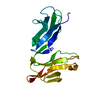
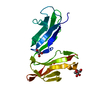
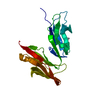
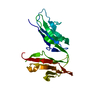
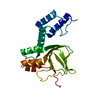
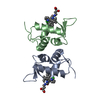
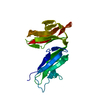
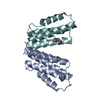


 PDBj
PDBj









